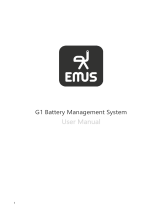Connection Setup
Setup
1. Connect the module to the REC BMS via RS-485 connection using included harness.
2. Connect the power supply to the REC Wi-Fi module. See Table 1 for power supply restrictions.
3. If connecting the module for the first time, the device will set up an access point, with default
credentials (SSID: REC_BMS, PASS: none). If this does not happen, please reset the device by
holding factory reset button for 20 s.
4. Using a Wi-Fi supported device, connect to the access point REC-BMS_AP.
5. Open your browser and go to IP address 192.168.1.184 by typing it on your browser’s top line.
If successful it will open the Main Menu. You should now see your battery pack status. If the
“REC BMS not found“ is shown, then you will need to set up your communication parameters.
Remember that your Wi-Fi module can connect to any REC BMS connected to your RS485
network. Select the Firmware tab from the Main menu and set your Send and Receive
addresses in Communication Settings to match the connected REC BMS device (1Q BMS has a
default RS-485 address of 1, ABMS address 2 and 9M Master BMS address 16).
The Wi-Fi module can be configured for direct access (AP) or integrated into your home network (STA).
To access it remotely it will need to be integrated into your home network as an STA device and port
forwarding set up. This is configured within your home router and is not covered here as each
manufacturer handles it differently.
Setting the device to access point (AP mode)
1. Connect to the Wi-Fi device.
2. Select the Firmware tab from the Main menu.
3. Change the Wi-Fi name and Wi-Fi password (up to 50 ASCII signs for both) to
desired credentials and confirm with Submit button.
4. Device will restart and set up the new access point.
Connecting the device to an existing network (STA mode)
1. Connect to the Wi-Fi device.
2. Select the Firmware tab from the Main menu.
3. Change the Wi-Fi name and Wi-Fi password (up to 50 ASCII signs for both) of the
desired network and confirm with Submit button.
4. If existing network is not found it will revert an access point with set credentials, so
you maintain your link and can try again.
5. If the Wi-Fi module finds and connects to the existing network access point Wi-Fi
























